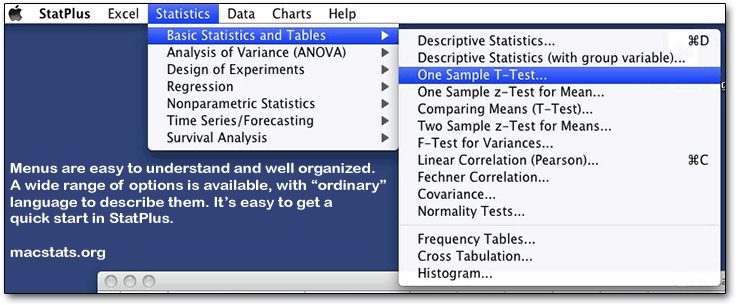

- #Descriptive analysis in excel for mac how to#
- #Descriptive analysis in excel for mac software#
- #Descriptive analysis in excel for mac code#
- #Descriptive analysis in excel for mac Pc#
StatView was initially distributed by BrainPower Inc from California. Contents of the analysis window could be copied either as text or as a PICT.
#Descriptive analysis in excel for mac how to#
The user then had to choose from another menu how to view the regression in a separate window, either as a table, in which case the regression equation and ANOVA were displayed, or as a scattergram, in which case a graph of the data and the regression line were shown.
#Descriptive analysis in excel for mac Pc#
By designating number of years using a PC as an x variable and IQ as a y variable, the user could then choose from a menu to perform a regression. Then the user used the application's menus to choose descriptive statistics or inferential statistics.įor example, a user's spreadsheet might contain columns for names of a participant in a survey (a string), sex (a category variable), IQ (integer), and years using a PC (real). To calculate statistics, a user clicked on particular column headings, designating them as an x value and one or more y values. Category data were used to perform inferential statistical tests such as t tests, ANOVAs, and chi square tests. Category data looked like strings (e.g., a column headed "sex" would have entries of "male" and "female", but these were coded by the application as integers).

Columns had informative headings rows were numbered. A user saw a spreadsheet of his or her data, comprising columns that could be integers, long integers, real numbers, strings, or categories, and rows that were usually cases (such as individual people for psychology data). StatView was one of the first statistics applications to have a graphical user interface, capitalizing on the Macintosh's. StatView is a statistics application originally released for Apple Macintosh computers in 1985.

JSTOR ( December 2018) ( Learn how and when to remove this template message).Unsourced material may be challenged and removed. Please help improve this article by adding citations to reliable sources. Moreover, if you take my next learning point, use this opportunity to set up templates for you to analyse your data sets: that means, you automate the ToolPak elements once and that is it!įinally, many elements of the ToolPak return non volatile results which means that if you change your data, you have to run the ToolPak again.This article needs additional citations for verification. Look at the screenshot of the output from R.īy the way, as a novice or beginner level user of Excel, there is a lot to learn from manually automating what’s in the ToolPak. That’s it! This is what I get from my current data set, sales values: not exactly the same as the ToolPak but my point is, it is very easy to replicate.
#Descriptive analysis in excel for mac code#
How about R and R Studio, however? Open source, free, with massive amounts of support? Of course, it takes time to learn R but here is the code for some descriptive statistics using the psych package in R:
#Descriptive analysis in excel for mac software#
Other answers have mentioned statistics software packages and that’s fine except they might not be free! Yes, if you are a student, your college or university is likely to have statistics software free for you to use. In that case, I often demonstrate to Mac users how to create and automate the functions in the ToolPak: correlation matrix, regression analysis, moving averages, descriptive statistics … the others as well!ĭescriptive statistics, for example, could be, for data in column A: If you use Excel on a Mac the chances are that you are not running Excel 2016 for the Mac and that your Mac does not have the ToolPak at all … I know, older versions have it and I know you can get alternatives! Someone asked this question in Quora and here is my answer which I think many of you will find useful:


 0 kommentar(er)
0 kommentar(er)
